Welcome to the first Newsletter of 2011. The recent holiday period has taken its toll on this edition and we are missing a main article and our usual Medicinal Plant of the Month. In their place we have a report from Alison Foster outlining the results of last autumn's tenth summit of the Convention on Biological Diversity and some recent news from our Associates. Normal service will be resumed in February.
In the meantime do not forget to book your place at our forthcoming events; Medicinal Plants: From Crop to Cure? on 29 March and Biofortified and Functional Food: A Healthy Future? on 19 May.
Editor
Nagoya Biodiversity Summit and the GSPC, October 2010

Also updated at the summit was the Global Strategy for Plant Conservation (GSPC). The new targets are aimed at the period 2011-2020. Although no individual target of the first GSPC was fully met, the strategy has been widely considered successful. The updated GSPC states as its vision 'Without plants there is no life. The functioning of the planet, and our survival, depends upon plants. The Strategy seeks to halt the continuing loss of plant diversity.' The 16 new and updated targets are designed to provide guidance for the setting of national plant targets. These 16 targets fall under five objectives:
- Objective I: Plant diversity is well understood, documented and recognised
- Objective II: Plant diversity is urgently and effectively conserved
- Objective III: Plant diversity is used in a sustainable and equitable manner
- Objective IV: Education and awareness about plant diversity, its role in sustainable livelihoods and importance to all life on Earth is promoted
- Objective V: The capacities and public engagement necessary to implement the Strategy have been developed.
Within the Horticulture group of the SCI, we should bear in mind these 16 targets as we go about our daily work. Which of the targets and objectives apply to us? Whilst we cannot ignore any of them, maybe the following three targets are particularly relevant.
- Target 6: At least 75 per cent of production lands in each sector managed sustainably, consistent with the conservation of plant diversity.
- Target 10: Effective management plans in place to prevent new biological invasions and to manage important areas for plant diversity that are invaded.
- Target 14: The importance of plant diversity and the need for its conservation incorporated into communication, education and public awareness programmes.
In addition to the adoption of these strategic plans, a new international protocol is to be implemented on access to and sharing of the benefits from the use of the genetic resources of the planet. It is now time to look forward to the coming decade and work together not only to halt the loss of biodiversity but to make sustainable use of the resources we still have available to us.
Alison Foster
Oxford Botanic Garden
News from our Associates
SCORE Practical Science Project - Nominations are needed

Biology Challenge - Does your organisation wish to submit a question?
The Society's Special Interest Group (SIG), UK Biology Competitions, organises the annual Biology Challenge for pre-GCE pupils. Ideas for questions are needed for the 2011 - 2012 Biology Challenge exam paper. As well as questions based on the school curriculum, Biology Challenge also rewards those students whose knowledge of biology has been increased by reading books, magazines and newspapers as well as watching natural history programmes. If your organisation would like to recommend a question, or develop closer working links with the UK Biology Competitions SIG, please contact Rachel Forsyth.
Changes at BIAC

SOB responds to the Wolf Review on Vocational Education
In the Society of Biology's response they give views on the principles for qualification development; the importance of offering learners the opportunity to follow a vocational pathway; and the importance of targeted and unbiased Information, Advice and Guidance.
CHA at Growtech Eurasia

CHA's next event will be the UK pavillion at IPM in Essen, Germany, followed by Fruit Logistica and Salon du Vegetal.
Plant of the Month
Manihot esculenta -
Cassava, Euphorbiaceae
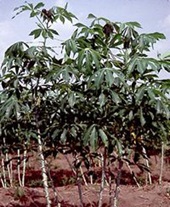
The plant is a perennial shrub which forms hard elongated tubers in the earth as storage organs and it is these that are eaten. These tubers contain twice as much starch as a potato. Like all members of the Euphorbiaceae, cassava stems and roots exude a milky sap when cut. This sap contains two cyanogenic glucoside toxins, linamarin and lotaustrain both of which readily produce hydrogen cyanide when decomposed by the enzyme linamarase which is present in the cell sap. The quantity of these toxins varies between 20mg/kg in 'sweet' varieties up to 1g/kg in 'bitter' varieties. While it would seem sensible to grow the sweet varieties, in fact bitter varieties are often favoured, as the bitterness protects the crops from being eaten by predators.
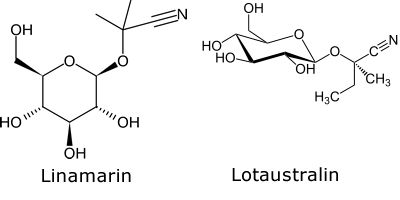
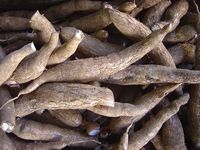
Astonishingly, people living in malarial regions wash their cassava less carefully, leaving poisonous linamarin in the cassava flour and allowing cyanide to accumulate in the bloodstream of those consuming it. Together with the protein deficiency caused by a diet overly reliant on cassava, this inhibits the development of malaria parasites. I think I'll stick to quinine etc.
Horticulture Industry News
For the very latest horticultural news follow us on Facebook and or
Twitter.
International Year of Chemistry: 2011

International Year of Forests: 2011
The United Nations General Assembly has also declared 2011 as the International Year of Forests to raise awareness on sustainable management, conservation and sustainable development of all types of forests. In the UK the Forestry Commission is playing its part and will make a full contribution to the UK's response with a programme of educational, community and recreational events throughout the year.
New Year's Honours:
Earl of Selborne
Horticulturist John Selborne, 4th Earl of Selborne, has been made a Knight Grand Cross of the Order of the British Empire for his services to science. His family company in Hampshire, Blackmoor Estates, includes a top fruit and soft fruit nursery, orchards and fruit storage and grading facilities.
He has been a member of the Apple and Pear Development Council, Chairman of Hops Marketing Board, Chairman of the Agricultural and Food Research Council, Chairman of the Joint Nature Conservation Committee and Chairman of the trustees of the Royal Botanic Gardens Kew.
Bill Simpson
Former principal of Pershore College and a past President of the Institute of Horticulture has been made an MBE for services to horticulture and the community. More
Useful websites:
UK Plant Science, www.plantsci.org.uk, is a central resource for all those involved in Plant Science Research. It brings together a unique combination of expertise in model and crop biology, ecology and biodiversity.
The Plant List, www.theplantlist.org, is a working list of all known plant species. Arising from a collaboration between the Royal Botanic Gardens, Kew and Missouri Botanical Garden, version 1 aims to be comprehensive for species of Vascular plant (flowering plants, conifers, ferns and their allies) and of Bryophytes (mosses and liverworts).
Fera launches consultation on Bemisia tabaci
Bemisia tabaci is a worldwide pest and virus vector which is not established in the UK but, according to Fera, could become a serious pest in protected environments, particularly glasshouse salad crops such as tomato and cucumber.
Hope for honey bees
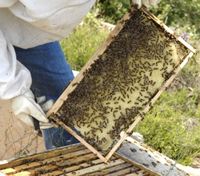
End of an Era
The last major UK chrysanthemum grower, Donaldsons is understood to have sold its site to berry grower Hall Hunter Partnership who will convert it to strawberry production. Simon Davenport Treasurer of the British Protected Ornamentals Association said, 'South Africa and the Dutch have taken a lot of the market. Many UK businesses simply got old and closed down because of economic pressures and fuel costs. No UK grower can supply in any quantity any more. Most are looking at supplying local markets instead'.
Meanwhile, 'seismic shifts' in the horticultural industry are ushering in opportunities through the 'great expansion of the grape, soft fruit and garden plant businesses,' added Colin Frampton, although this new period is witnessing some local industries 'passing away'. (FPJ, 17 Dec 2010) More and More
EMR research to help strawberry industry
Following two years of commercial trials managed by Sarah Troop and Meiosis Ltd, six varieties have been released and approved by UK supermarkets. The varieties include the June bearers, Elegance, Fenella, Cupid, Sweetheart and EM1119, together with the everbearer, Finesse. These varieties carry no exclusive licence arrangements and so are available for all growers to use. They provide a season-long range of alternative varieties that are said to incorporate excellent fruit quality and significant yield advantages with improved resistance to soil-borne diseases like Verticillium (South East Farmer, December 2010).
Help from Lavender
Scientists at East Malling Research are trying to find alternative ways to combat soil-borne disease, Verticillium dahlia, following the banning of the use of methyl bromide. An alternative approach involved biofumigation using plant-derived volatile chemicals to control soil-borne diseases. The scientists will use natural chemicals derived from lavender and brassica crops to suppress the fungus. This will involve the use of micro encapsulation technology developed by Essex-based Eden Research. These natural chemicals are less toxic to the environment. (South East Farmer, December 2010).
Applications sought
An industry partnership is to offer a new programme of science fellowships. The East Malling Trust (EMT), Horticultural Development Company (HDC) and the Horticultural Trades Association (HTA) have collaboratively developed the Horticultural Development Awards. Applications from scientific research institutions and universities are now being sought. It is envisaged that around five individual fellowships will be awarded, each worth up to £50,000 per annum and available for up to five years, starting from 1 April. The new fellowships are consistent with the findings of the Taylor Review, published earlier this year (FPJ, 17 December 2010).
Crop protection saves UK consumers £70bn
As spiralling development costs and restrictive new legislation threaten EU farmers' access to vital pesticide products, a new economic impact report by leading economist Sean Rickard of Cranfield University examines the true value of crop protection to the food chain and living standards. He concludes that without pesticides to keep weeds, pests and diseases in check, crop yields would fall to half their current levels and food prices would rise by 40%, an increase to UK consumers of some £70 billion per year in food costs.
Rabbits most costly invasive species
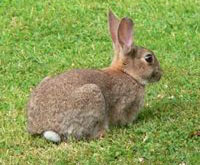
Evolution of potato blight pathogen traced
Researchers have traced the key genetic changes that enabled the plant pathogen responsible for the 1845 Irish potato famine (Phytophthora infestans) to jump from wild plant hosts to cultivated potatoes. These genetic clues could aid the development of fungicides and disease-resistant varieties of potato that the pathogen will find much more difficult to adapt to and overcome. The researchers identified the key genes by comparing the genetic make-up of the potato blight pathogen and several of its sister species. To do so, they sequenced the genomes of four of the potato blight's sister species, including Phytophthora phaseoli, which infects lima beans (Phaseolus lunatus). They computationally analysed and compared these genomes with the genome of the previously sequenced P. infestans. More
Race against climate change
A global search to save the wild relatives of wheat, rice, potato and other food crops from climate change has been launched. The Global Crop Diversity Trust (GCDT) said the campaign was designed protect global food supplies against changes in climate and strengthen international food security. Norway pledged 50 million US dollars (£31.8m) to the effort, which will look for 23 food species including barley, lentils, chickpeas and beans, and is being supported by Britain's Royal Botanic Gardens based in Kew, Surrey.
Scotts sells Global Professional business
The Scotts Miracle-Gro Company has announced plans to sell its Global Professional business to global fertiliser company ICL. The Global Professional section of the company markets professional products to commercial growers and those involved in ornamentals, turf, parks and green spaces and speciality agriculture all over the world. Scotts US professional seed business is not included in the offer.
Plants 'remember' winter to flower in spring
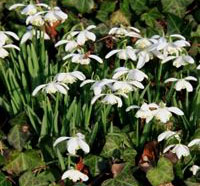
New fungal biopesticides
Two new biopesticides, both based on naturally-occuring fungi, will be available from horticultural supplier Fargro in the new year. The first, Prestop, is based on the fungus Gliocladium cantenulatum and can be used on a range of vegetable, salad and herb crops as well as ornamentals. It is suited to tackling foliar and root diseases including Botrytis, Phythium and Fusarium. Prestop can be applied using a foliar spray, through drip irrigation, or as a growing media treatment. Trials on tomatoes showed very little Botrytis on the treated plot.
The second product, currently nameless, until it is officially registered by the Chemicals Regulation Directorate contains the fungus Metarhizium anisopliae, which is used to control vine weevil. It can also be used to control other pests, such as Western flower thrips.
Kildare Growers Show set to return in 2011
Having carefully considered the findings of a review of the 'Kildare Show', Kildare Growers Group Ltd, has elected to focus their efforts on creating an event in July 2011 which will showcase the best of Irish horticulture, in association with Bord Bia (Irish Food Board).
Quotes of the Month
'Not everything that can be counted counts and not everything that counts can be counted'.
Einstein
Events Calendar
Other Events of Interest
BTME Harrogate Week
16 - 20 Jan, British and International Golf Greenkeepers Association
Harrogate, UK
Tropical Plant Industry Exhibition
19 - 21 Jan, Florida Nursery, Growers and Landscape Association
Fort Lauderdale, USA
IPM Essen
21 - 25 Jan, Messe Essen
Essen, Germany
Great Dixter: Past, Present and Future
27 Jan, Oxford Botanic Garden
Oxford, UK
Horticulture of Opium Poppy
7 - 11 Feb, International Society for Horticultural Science
Lucknow, India
GAN Trade Show
9 Feb, Golden Acres Nursery
Bournemouth, UK
Interaction of Pesticide Application and Formulation on Residues in Fruit and Vegetables
9 Feb, Association of Applied Biologists
Jealotts Hill, UK
MSP - Martha Schwartz Partners
10 Feb, Oxford Botanic Garden
Oxford, UK
Salon du Vegetal
15 - 17 Feb, UK Pavilion by Commercial Horticultural Association
Angers, France
Grower of the Year Awards
17 Feb, Haymarket Events
London, UK
Crop Protection in Southern Britain
23 Feb, Association of Applied Biologists
Impington, Cambridge, UK
The Woodland Year
24 Feb, Oxford Botanic Garden
Oxford, UK
Global Conference on Entomology
5 - 9 Mar
Chiang Mai, Thailand
The Trentham Estate: A Contemporary Revival
10 Mar, Oxford Botanic Garden
Oxford, UK
Sustainable Vegetable Production in South East Asia
14 - 17 Mar, International Society for Horticultural Science
Salatiga, Indonesia
New Ag International Conference & Exhibition
15 - 17 Mar, New Ag International
Cairo, Egypt
Wild Relatives of Subtropical and Temperate Fruit and Nut Crops
19 - 23 Mar, International Society for Horticultural Science
Davis, CA, USA
The Icing on the Cake
24 Mar, Oxford Botanic Garden
Oxford, UK
Forests and Global Change
28 - 30 Mar, British Ecological Society
Cambridge, UK
Organic Matter Management and Compost Use in Horticulture
4 Apr - 7 Apr 2011, International Society for Horticultural Science
Adelaide, Australia
Multitrophic Interactions in Soil
4 - 7 Apr, IOBC / WPRS
Cordoba, Spain
Innovative ideas in pest and weed control in field vegetables
13 Apr, Association of Applied Biologists
Rothamsted, UK
Trees, People and the Built Environment
13 - 14 Apr, Chartered Institute of Foresters
Birmingham, UK
Systems Approaches to Crop Improvement
14 - 15 Apr, Association of Applied Biologists
Rothamsted, UK
Vegetation Management
27 - 28 Apr, Association of Applied Biologists
Sheffield, UK
If you would like to advertise a forthcoming event please contact communications@soci.org
Horticulture Group Contact Details
For submitting ideas or to volunteer to be part of a committee or a group, please contact:
Acting Chairman - Peter Grimbly
Meetings Secretary - Marion Stainton
Minutes Secretary - Margaret Waddy
Newsletter Co-ordinator - Sue Grimbly, E: scihortigroup@btinternet.com
Group Coordinator - Zoe Daniel zoe.daniel@soci.org T: +44(0)20 7598 1594
